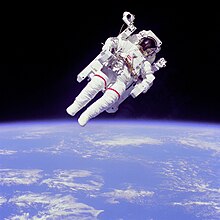Manned Maneuvering Unit
The Manned Maneuvering Unit ( MMU ) was a jet backpack that developed in the 1970s and only three space shuttle missions by astronauts during spacewalks (EVAs) was used.
The MMU was not part of the standard equipment of the US space shuttle, but was only carried when the mission required it. It was designed by the Martin Marietta company in Colorado for EVAs without being secured by the robotic arm or a line for rescuing an astronaut or for capturing floating equipment. It was housed in the cargo hold of the orbiter in the so-called Flight Support Station (FSS) . The astronaut exited the airlock, floated into the payload bay and stood in the FSS, which was equipped with footrests. Then the MMU was put on by engaging the knapsack on the astronaut's back with two locks on the inner part of the MMU.
The MMU was 127 cm high and 85 cm wide. It was equipped with two extendable armrests, at the end of which the control levers were attached. The unit was 69 cm with retracted arms and 122 cm deep with arms extended. For maneuvering, the MMU had 24 cold gas engines that worked with nitrogen gas . The total mass was 153.4 kg (including 10.6 kg of gas; two tanks of 5.3 kg each). The delta v of the MMU was a maximum of 23.4 m / s.
The MMU was only used on three missions in 1984. The system was first used on the STS-41-B mission in February by astronauts Bruce McCandless and Bob Stewart . All tests were successful, with the two moving up to 98 meters from the shuttle.
The second mission took place in April 1984 on STS-41-C . George Nelson flew to the Solar Max satellite, launched eight months earlier, with the MMU, but was unable to stabilize it. The shuttle's gripper arm finally caught the satellite two days later. After Solar Max was repaired and suspended again, James van Hoften undertook further tests with a second MMU.
For STS-51-A in November 1984, the MMU was used the last time. The satellites Westar VI and Palapa-B2 , which were launched by the shuttle in February, were recaptured and brought back to Earth. On the first EVA, Joe Allen flew to Palapa and took him to the shuttle. On the second exit, Dale Gardner undertook the same maneuver with Westar.
The same MMU units were used on each of the three flights (two per mission). After that, the MMU was never used again. NASA found it too risky to use it and its control turned out to be too imprecise. When working on the International Space Station (ISS) it is unusable because of its bulky dimensions.
The successor to the MMU is the - much smaller and lighter - Simplified Aid for EVA Rescue (SAFER).
See also
Web links
- Manned Maneuvering Unit (MMU) - National Air and Space Museum (English)
- Manned Maneuvering Unit (MMU) - Lockheed Martin (English)
- February 1984: Bruce McCandless - the first "human satellite" (raumfahrtkalender.de)

